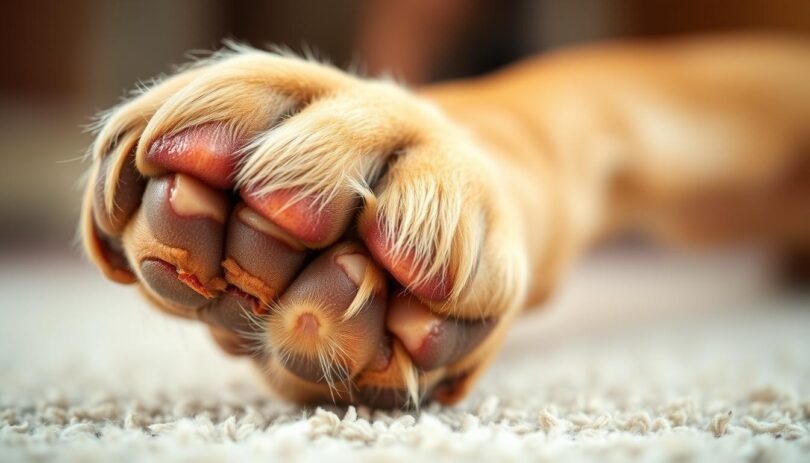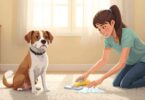Is it that furry friend of yours who chews its paws and it is just normal or is it a cry of help? Most pet owners explain such behavior away as normal, though constant nibbling may be an indication of underlying health problems. Whether it is allergies or infection, the causes of such habit demand more attention and the solutions are not always clear.
Some licking is normal, but regular biting or gnawing could indicate issues such as pododermatitis (inflammation of the skin), injuries or nervousness. These cases are usually accompanied by redness, swelling or discoloration around the toes or pads. Without treatment, secondary infections may occur, and they will make your companion feel even worse.
Identifying the root cause is critical. As an example, flea or environmental allergens could cause irritation. In other instances, stress or boredom drives the behavior. With the help of veterinary guidance, the proper diagnosis is done either by allergy testing, wound care, or behavioral testing.
This article looks at some of the ways to address them, including paw hygiene regimes, anti-anxiety devices, and when it is necessary to seek professional help. Learn the warning signs and preventive measures to take to ensure that your pet has healthy feet. To get similar information on other related behaviors, read more about excessive licking and how to resolve them.
Understanding Dog Chewing Paws Behavior
Licking or nibbling is typical animal behavior that is paw-oriented. Sometimes you should pay attention to their feet to clean them and facilitate natural grooming. Short periods following walks or playtime are not of much concern.
Normal Habits vs. Red Flags
Healthy grooming involves short, sporadic sessions. Pets often pause when distracted. It becomes a problem when they are obsessive about a single area, when they disregard toys or when they are agitated. Look out of raw skin, split nails or abnormal smell around the pads.
Critical Signs Requiring Action
Persistent chewing despite intervention suggests discomfort. Redness between the toes is usually caused by allergies, and symmetrical inflammation can be caused by stress. In case of limping or changes in the color of fur due to saliva stains, go to the vet as soon as possible.
Behavioral patterns matter too. Anxiety-driven habits typically worsen during thunderstorms or separations. Frequency and triggers should be monitored early so that professionals can identify the causes such as fleas or arthritis before they lead to complications.
Common Causes Behind Dog Chewing Paws
Does your friend stare at his or her feet more than usual? Continuous focus on this region is usually based on physical pain or environmental stimuli. The source should be determined by knowing the internal health factors and external irritants.
Allergies and Infections
Allergic reactions are a leading culprit. Itching may be caused by food proteins such as beef or dairy, seasonal pollen, and household chemicals. Swollen pads or inflamed skin between the toes is a frequent indication of pododermatitis-which is painful inflammation associated with bacterial or yeast overgrowth.
Parasites like fleas and mites worsen the problem. Their bites cause allergic dermatitis, prompting excessive licking. Left untreated, open sores may develop, inviting secondary infections. A vet can do tests to determine allergens or prescribe antifungal medication.
Pain, Injury, and Arthritis
Some pets chew their feet as a remedy to discomfort caused by sprains, cracked nails or burns. Arthritic joints may be gnawed by older animals, who think they are hurting, when the stiffness is all that is painful. Overgrown nails can curl into pads, creating constant pressure.
Early diagnosis is key. Indicatively, a 2022 study reported 40 percent of the paw-related chewing incidences to have undiagnosed injuries. Mobility problems or invisible injuries are evaluated by professionals using X-rays or physical examination, which means that they will be taken care of in time.
Recognizing Health and Skin Issues in Dogs
Skin issues usually present themselves in delicate body parts such as feet. Detection at an early stage prevents the occurrence of minor irritations that may develop into chronic conditions. Pododermatitis and other common dermatological problems are two important issues that pet owners should be on the lookout.
Pododermatitis Indicators
This painful inflammation affects nail beds and pads. Inspect the swelling of tissue, red streaks between toes or crusty deposits around claws. A 2023 veterinary study reported that 62 percent of cases are associated with secondary bacterial or yeast infections which are usually characterized by yellow discharge or sour smell.
Other Skin Conditions
The bacteria infection causes scaly red patches, and yeast overgrowth leaves greasy film. Mites and other parasites enter sensitive skin and make it itchy. After grooming, normal paw hair ought to feel a bit wet-not matted or sticky.
Check between toes weekly for unusual warmth or lumps. Darkened fur from saliva stains often signals persistent discomfort. In case you notice the pads are cracked or have bumps, make sure to visit a vet within 48 hours to prevent complications.
Quick action matters. Minor irritation can be treated with simple solutions, such as hypoallergenic wipes, but open sores should be treated by a professional. Take photos of the changes in the documents that will assist your vet to identify patterns during examination.
Behavioral and Emotional Triggers in Canine Paw Chewing
Although physical conditions are frequently in the limelight, the emotional reasons are also important in the case of pets paying attention to their feet. Psychological distress may lead to compulsive licking or gnawing, which will become a coping mechanism, thus forming a cycle that will continue even after the original triggers are gone.
Anxiety and Stress
Nervous behaviors can be induced by loud noises, changes in schedule or separation with owners. When animals are stressed, many of them lick their paws as a way of self-comfort, just like humans bite their nails. According to research on animal behavior conducted in 2023, 38 percent of dogs formed repetitive paw-oriented behaviors following significant household disturbances.
Other symptoms such as pacing or whining are usually accompanied by stress-related chewing. Regular habits and tranquilizing tools such as pheromone diffuser minimize the spikes of anxiety. In extreme cases, vets can prescribe anti-anxiety drugs combined with behavior therapy.
Boredom and Habit Formation
Under-stimulated pets frequently turn to paw attention as entertainment. This behavior may become habitual unless there is sufficient playtime or walks. Puzzle feeders stimulate the ability to solve problems, and interactive toys engage the energy in a positive way.
The exercise needs of the dog differ depending on the breed but are usually 30 90 minutes a day. Note social withdrawal or loss of interest in favorite games these are usually indicators of unmet mental needs. In case redirection of attention does not work, seek the help of a certified behaviorist to overcome ingrained patterns without any harm.
Proven Remedies and Treatments for Dog Chewing Paws
The combination of professional treatment and home-based management is usually the most successful when your pet is obsessively targeting their feet. The combination of treating immediate pain and causes is a way to break the cycle.
When to Seek Veterinary Care
Plan an exam in case of such symptoms as swelling or discharge. Vets can prescribe antibiotics when there is an infection or antihistamines to relieve allergy. The extreme ones may involve the injection of steroids or surgical removal of damaged tissue. Always complete prescribed medication courses to prevent recurring issues.
Effective Home Management
In case of mild irritation, feet should be soaked in a diluted solution of apple cider vinegar to decrease bacteria. Apply coconut oil to cracked pads daily. Use dog-safe booties to block access during healing. Keep nails trimmed to avoid the pressure of ingrown claws.
These steps combined with puzzle toys will distract anxious pets. If redness persists after 3 days, consult your vet. Record any behavioral or physical alterations to assist professionals to make changes to treatment regimes in a timely manner.
Preventative Measures for a Healthier Canine Lifestyle
Active care is essential in keeping your pet comfortable and cheerful. Routines involving paw health and mental stimulation on a daily basis can greatly diminish risks associated with irritation- or stress-based habits.
Paw Hygiene and Grooming
Examine feet after walks to see whether they have some debris such as grass seeds or small rocks. Wash off allergens, dirt or salt residues with lukewarm water. To avoid overgrowth, nails must be clipped every 3-4 weeks to avoid overgrowth that strains the joints and alters gait.
To avoid cracking in dry weather, apply pet-safe balms to moisturize pads. Clip extra fur between the toes to reduce matting and bacteria growth. When the pavement is either snowy or hot, sensitive skin is covered by protective booties to prevent exposure to extreme temperatures.
Exercise and Mental Stimulation
Breed-specific walks on a daily basis help build muscles and reduce restlessness. Interactive toys like treat-dispensing puzzles challenge problem-solving skills. Change activities each week-agility courses or scent games will keep brains stimulated.
Plan play time when the energy level is high e.g. in the morning or the evening. In anxious pets, distraction during stressful events is provided by calming aids such as chew-resistant lick mats. Consistent routines build confidence and reduce boredom-related behaviors.
Final Thoughts on Keeping Your Dog’s Paws Healthy
To ensure foot health in your pet, you have to be aware and act in time. Whether it is allergies or anxiety-related habits, there are various causes that may cause them to be uncomfortable in their feet. The redness between the toes or alteration of grooming habits can be detected early and avoid turning into serious problems.
Routine care plays a pivotal role. Debris checking, moisturizing pads, and customized exercise are reduced by checking regularly. Combine them with mental stimulation as a way of dealing with boredom which is one of the most common causes of repetitive behaviors.
If unusual signs persist, professional guidance ensures accurate diagnosis. Veterinarians are able to detect underlying causes, whether dietary, environmental irritants or joint pain. Proactive measures, combined with prompt treatment, safeguard long-term well-being.
Keep in mind: Regular foot care is not only about correcting the problems, but also about preventing them. Consult a vet when you see constant licking or swelling. Your vigilance today ensures many happy, healthy adventures ahead.
FAQ
What should I do to know whether my pet chews on his paws as a normal behavior or as a health problem?
A bit of licking is a part of the grooming process, however, excessive chewing, especially with redness, swelling, or hair loss is usually an indication of allergies, infection or trauma. Watch out on overemphasis on the area or noticeable skin changes.
Can food sensitivities cause pets to bite their feet?
Yes. Allergic reactions may occur due to proteins such as chicken or beef as well as grains and additives. Speak to your vet regarding elimination diets or allergy testing to see what triggers it.
What home treatments help soothe irritated pads?
Wash with chlorhexidine wipes and vet-approved balms such as Musher Secret and soak in Epsom salt to help with minor inflammation. Avoid human creams containing steroids or toxic ingredients.
Are parasites like fleas a common reason for toe-chewing?
Absolutely. Flea allergy dermatitis often targets the lower body. Look in the area of the tailbase and between toes to find flea dirt. Itch can be halted by monthly preventatives such as NexGard or Simparica.










Leave a Comment